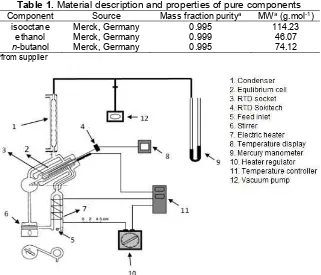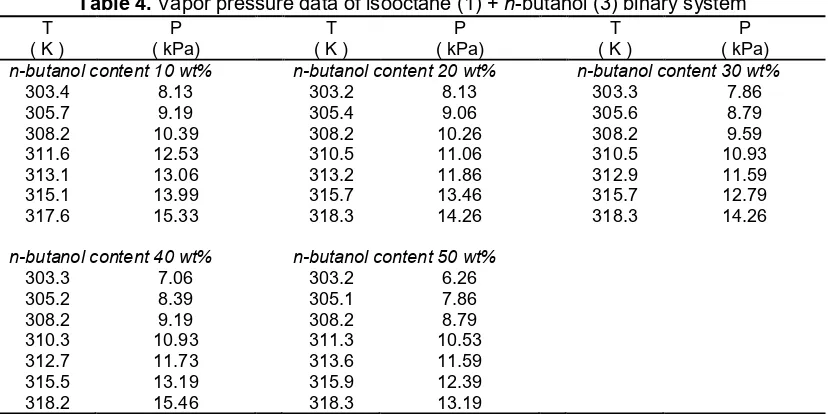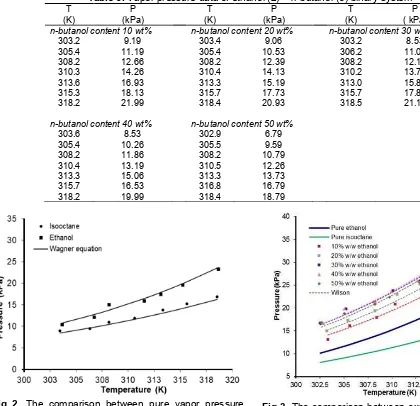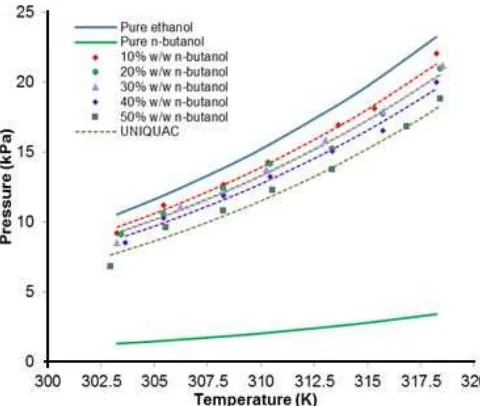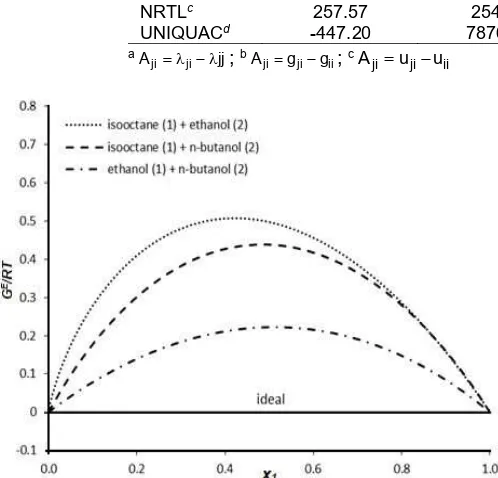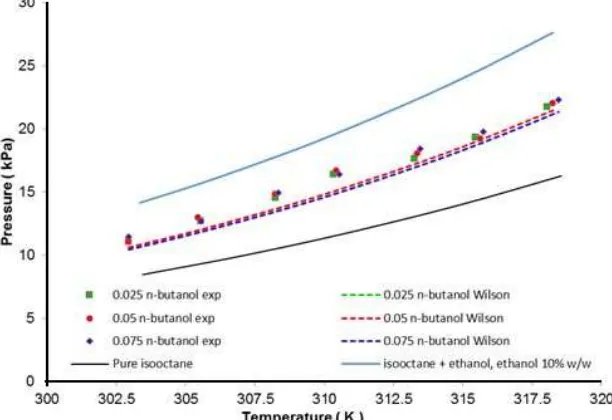The Addition of N-Butanol in Ethanol-Isooctane Mixture to Reduce Vapor Pressure
of Oxygenated-Gasoline Blend
Rendra Panca Anugraha, Zul Akbar Andi Picunang, Annas Wiguno,
Rizky Tetrisyanda, Kuswandi, and Gede Wibawa
*Department of Chemical Engineering, Institut Teknologi Sepuluh Nopember (ITS), Kampus ITS Sukolilo, Surabaya 60111, Indonesia
Received July 17, 2017; Accepted October 27, 2017
ABSTRACT
In this work, vapor pressure of binary systems for isooctane + ethanol, isooctane + butanol and ethanol + n-butanol and ternary system for isooctane + ethanol + n-n-butanol were measured in the temperature range from 313.15 to 318.15 K using the inclined ebulliometer. The experimental results showed that the existence of n-butanol in isooctane decreases the vapor pressure of mixture, while increasing n-butanol fraction in ternary isooctane-ethanol-n-butanol mixture decreased vapor pressure of mixture. Experimental data for binary systems studied were correlated with Wilson, NRTL and UNIQUAC models with average relative deviation (ARD) of 3.5%. The optimized binary parameter pairs obtained in this work were used to estimate the ternary system. The Wilson model gave the best performance for estimation of ternary system with ARD of 5.4%. All systems studied showed non-ideal solution with positive deviation from Raoult’s law.
Keywords:vapor pressure; n-butanol; ethanol; isooctane; gasoline
ABSTRAK
Pada penelitian ini, tekanan uap sistem biner isooktana + etanol, isooktana + n-butanol dan etanol + n-butanol serta tekanan uap sistem terner isooktana-etanol-n-butanol telah diukur pada suhu 313,15–318,15 K menggunakan inclined ebulliometer. Hasil eksperimen menunjukkan bahwa adanya n-butanol dalam isooktana dapat menurunkan tekanan uap campuran. Peningkatan fraksi n-butanol pada campuran terner isooktana-etanol-n-butanol dapat menurunkan tekanan uap pada campuran tersebut. Data eksperimen sistem biner telah dikorelasi dengan model Wilson, NRTL dan UNIQUAC dengan average relative deviation (ARD) 3,5%. Parameter biner yang telah dioptimasi digunakan untuk memperkirakan tekanan uap sistem terner. Model Wilson memberikan perkiraan tekanan uap terbaik pada sistem terner dengan ARD 5,4%. Semua sistem yang dipelajari menunjukkan larutan non-ideal dengan penyimpangan positif dari Hukum Raoult.
Kata Kunci:tekanan uap; n-butanol; etanol; isooktana; bensin
INTRODUCTION
The usage of base gasoline as fuel gives some environmental issues because of its high carbon monoxide (CO) and unburned hydrocarbons content in exhaust gas emission [1]. Oxygenated compounds are required as fuel additive to reduce exhaust gas emission. Alcohols have been known as oxygenated compound and octane booster in gasoline [2]. One of the alcohols widely used as gasoline additive is ethanol because of its availability from biomass[3]. Ethanol has high octane number [2] and low toxicity [4] that may increase the quality of gasoline. However, ethanol has low heating value and it increases the vapor pressure significantly when mixed with gasoline [5]. The vapor pressure for mixtures is one of important physical property of materials that must be concerned for
designing gasoline blend. The increasing of vapor pressure gives several problems such as rising evaporative emission and tendency to vapor lock in automobile engine [6].
Table 1.Material description and properties of pure components
Component Source Mass fraction puritya MWa(g.mol-1)
isooctane Merck, Germany 0.995 114.23
ethanol Merck, Germany 0.999 46.07
n-butanol Merck, Germany 0.995 74.12
afrom supplier
Fig 1.The schematic diagram of inclined ebulliometer used in this work
additive to get its advantage with suppress the deficiency and keep the economic value.
In order to design applicable oxygenated (n -butanol/ethanol) - gasoline blend, the knowledge of vapor pressure values for the systems containing ethanol, n-butanol and isooctane is necessary. Several studies have been reported for vapor pressure measurement of the binary systems containing isooctane, ethanol and n-butanol [10-12]. There was only one study reporting for vapor pressure of the ternary system containing isooctane, n-butanol and 1-hexene (without ethanol) [13]. Based on our knowledge, there are no published data in DIPPR (The Design Institute for Physical Properties), Dechema, NIST (National Institute of Standards and Technology) or related journals for vapor pressure measurement of the ternary system containing isooctane, ethanol and n-butanol.
Therefore in this study, vapor pressure of binary systems for isooctane + ethanol, isooctane + n-butanol and ethanol + n-butanol and ternary system for isooctane + ethanol + n-butanol were measured in the temperature ranging from 313.15 to 318.15 K using the inclined ebulliometer. The experimental data of binary systems were correlated using Wilson [14], NRTL [15] and UNIQUAC [16] models to obtain binary interaction parameters. These binary parameters were used to predict the vapor pressure of ternary system. The
predicted vapor pressure values were compared with the experimental ternary system data.
EXPERIMENTAL SECTION
Materials
Ethanol, n-butanol and isooctane were used as materials in this work. These materials were purchased from Merck, Germany with materials properties and descriptions are shown in Table 1 and no additional purification was done with the materials.
Instrumentation
Table 2.Parameter for the Wagner equation of pure compounds*.
Component A B C D Tc (K) Pc (bar)
isooctanea -7.389 1.2529 -3.1661 -2.2200 544 25.7
ethanola -8.518 0.3416 -5.7368 8.3258 513.9 61.4
n-butanola -8.007 0.5378 -9.3424 6.6869 563.1 44.2
aRef [19]
*lnPrsat
A(1 Tr) B(1 Tr) 1.5C(1 Tr) 2.5D(1 Tr) 5
/ Tr, where TrTTc andsat sat
r P
P Pc
Table 3.Vapor pressure data of isooctane (1) + ethanol (2) binary system
T P T P T P
(K) (kPa) (K) (kPa) (K) (kPa)
Ethanol content 10 wt% Ethanol content 20 wt% Ethanol content 30 wt%
303.3 13.06 303.2 14.93 302.5 16.66
305.6 16.13 305.4 17.19 305.2 19.73
308.4 17.86 308.2 19.33 308.2 21.19
310.3 20.79 310.5 22.93 310.1 23.73
313.2 22.79 312.9 25.19 312.9 25.86
315.5 25.86 315.4 27.19 315.3 29.06
318.2 27.86 318.2 29.46 317.5 31.73
Ethanol content 40 wt% Ethanol content 50 wt%
302.8 16.66 302.6 16.79
305.0 19.86 305.0 18.79
308.2 21.33 308.2 20.79
309.9 23.59 309.7 22.39
312.6 25.99 312.8 25.59
315.2 29.59 315.2 28.13
317.7 32.39 318.0 31.73
Table 4.Vapor pressure data of isooctane (1) +n-butanol (3) binary system
T P T P T P
( K ) ( kPa) ( K ) ( kPa) ( K ) ( kPa)
n-butanol content 10 wt% n-butanol content 20 wt% n-butanol content 30 wt%
303.4 8.13 303.2 8.13 303.3 7.86
305.7 9.19 305.4 9.06 305.6 8.79
308.2 10.39 308.2 10.26 308.2 9.59
311.6 12.53 310.5 11.06 310.5 10.93
313.1 13.06 313.2 11.86 312.9 11.59
315.1 13.99 315.7 13.46 315.7 12.79
317.6 15.33 318.3 14.26 318.3 14.26
n-butanol content 40 wt% n-butanol content 50 wt%
303.3 7.06 303.2 6.26
305.2 8.39 305.1 7.86
308.2 9.19 308.2 8.79
310.3 10.93 311.3 10.53
312.7 11.73 313.6 11.59
315.5 13.19 315.9 12.39
318.2 15.46 318.3 13.19
Procedure
The solution of certain composition was prepared gravimetrically and introduced into ebulliometer cell. After that, the vacuum pump was used to remove air and impurities from the apparatus. The temperature controller was set at desired temperature by heating the heater flask. When the temperature was reached and
Table 5.Vapor pressure data of ethanol (2) +n-butanol (3) binary system
T P T P T P
(K) (kPa) (K) (kPa) (K) ( kPa)
n-butanol content 10 wt% n-butanol content 20 wt% n-butanol content 30 wt%
303.2 9.19 303.4 9.06 303.2 8.53
305.4 11.19 305.4 10.53 306.2 11.06
308.2 12.66 308.2 12.39 308.2 12.13
310.3 14.26 310.4 14.13 310.2 13.73
313.6 16.93 313.3 15.19 313.0 15.86
315.3 18.13 315.7 17.73 315.7 17.86
318.2 21.99 318.4 20.93 318.5 21.19
n-butanol content 40 wt% n-butanol content 50 wt%
303.6 8.53 302.9 6.79
305.4 10.26 305.5 9.59
308.2 11.86 308.2 10.79
310.4 13.19 310.5 12.26
313.3 15.06 313.3 13.73
315.7 16.53 316.8 16.79
318.2 19.99 318.4 18.79
Fig 2. The comparison between pure vapor pressure
experimental data and calculated values Fig 3.calculated vapor pressure by the Wilson model forThe comparison between experimental data and isooctane + ethanol binary system
RESULT AND DISCUSSION
Vapor Pressure of Pure Components
The vapor pressures of pure components have been measured for isooctane and ethanol. These pure vapor pressure experimental data were compared with literature values which were calculated using Wagner equation with constants which were listed in Table 2. The comparison between pure vapor pressure experimental data and calculated values are shown in Fig. 2. From this comparison, the experimental data agreed well with the literature values with average relative deviation (ARD) value of 3.5% for isooctane and 3.0% for ethanol.
Vapor Pressure of Binary Systems
Fig 4. The comparison between experimental data and calculated vapor pressure by the NRTL model for isooctane +n-butanol binary system
Fig 5.The comparison between experimental data and calculated vapor pressure by the UNIQUAC model for ethanol +n-butanol binary system
Table 6.Vapor pressure data of isooctane (1) + ethanol (2) +n-butanol (3) ternary system
T P T P T P
(K) (kPa) (K) (kPa) (K) (kPa)
Isooctane 92.5%, ethanol 5%, n-butanol 2.5% (wt%)
Isooctane 90% ethanol 5%, n-butanol 5% (wt%)
Isooctane 87.5%, ethanol 5%, n-butanol 7.5% (wt%)
302.9 11.06 302.9 11.06 302.9 11.46
305.5 12.66 305.4 12.93 305.5 12.66
308.2 14.53 308.2 14.79 308.3 14.93
310.3 16.39 310.4 16.66 310.5 16.39
313.2 17.59 313.3 17.99 313.4 18.39
315.4 19.33 315.6 19.19 315.7 19.73
318.0 21.73 318.2 21.99 318.4 22.26
Table 7. Physical properties and parameters of pure components used in the activity coefficients correlationa
component VL/cm3.mol-1 r q
isooctane 166.62 5.8463 5.008
ethanol 58.68 2.5755 2.588
n-butanol 91.96 3.9243 3.668
aRef [19]
of chemical structure and polarity between isooctane and ethanol. Meanwhile, the n-butanol addition in isooctane caused lower vapor pressure than pure isooctane vapor pressure as shown in Fig. 4. The isooctane – n-butanol mixtures showed non-ideal solution because after the addition of n-butanol up to 50% w/w, the vapor pressure were slightly changing from isooctane pure vapor pressure. This happens because isooctane and butanol have different chemical groups (hydrocarbon and alcohol) even thoughn-butanol has longer chain carbon. Fig. 5 showed the n-butanol addition in ethanol which caused lower vapor pressure than the pure ethanol vapor pressure. The ethanol – n
-butanol mixtures showed non-ideal solution even these compounds have the same groups. This happens becausen-butanol has longer chain carbon compared with ethanol.
The experimental data of binary systems were correlated by using Wilson, NRTL and UNIQUAC models to obtain the fitted binary parameters. The physical properties and parameters of each component used in the activity model correlation were shown in Table 7. Barker’s method [18] was used as objective function to optimize the binary parameters for these systems studied in this work which was described by Equation (1):
2n
i,cal i,exp i 1
OF P P
(1)Table 8.The fitted binary parameter of activity coefficient model and average relative deviation (ARD)
Model Parameters ARD(%)
A12(cal·mol-1) A21(cal·mol-1)
isooctane (1) + ethanol (2)
Wilsona 5065.53 1091.53 3.69
NRTLb -272.08 2335.45 0.2 3.65
UNIQUACc 46.34 410.55 3.53
isooctane (1) +n-butanol (3)
Wilsona 524.07 1008.69 3.33
NRTLb 1077.33 23.60 0.2 3.26
UNIQUACc 516.65 -186.61 3.21
ethanol (2) +n-butanol (3)
Wilsonb 517.99 108.91 3.71
NRTLc 257.57 254.00 0.2 3.88
UNIQUACd -447.20 7876.21 3.82
a ji ji
A jj;bAjigjigii;cAjiujiuii
Fig 6. The excess gibbs energy values of the binary systems at 308.15 K
as ideal gas and the calculated vapor pressure can be obtained using the following equation:
m
wheremis the number of component in the mixture,xiis
the liquid mole fraction of component i, γi is the activity
coefficient of component i and Pis is the pure vapor
pressure of the componentiwhich calculated by Wagner equation. The best fitted binary interaction parameters were listed in Table 8.
The average relative deviation (ARD) of vapor pressure between experimental data and calculated values were used to evaluate the correlation which is described by:
For isooctane (1) + ethanol (2) system, the experimental data were well correlated using Wilson, NRTL and UNIQUAC models with ARD values of 3.7%, 3.% and 3.53% respectively. Isooctane (1) +n-butanol (3) system give ARD values of 3.3%, 3.3% and 3.2% respectively. Ethanol (2) + n-butanol (3) system give ARD values of 3.7%, 3.9% and 3.8% respectively. Fig. 3–5 showed the comparison between experimental data and calculated vapor pressure by the models. The correlation lines in the Figures showed good agreement with the experimental data.
From the activity coefficient analysis based on Wilson, NRTL, and UNIQUAC models, the physical behavior may be explained for each binary system studied. The non-ideality of solution could be expressed as excess Gibbs energy where excess Gibbs energy is the deviation between actual energy Gibbs and ideal energy Gibbs. Excess Gibbs energy were calculated from activity coefficient as described by:
where
G
E is the excess Gibbs energy of solution, Risthe universal gas constant and T is the temperature condition.
Fig. 6 showed the excess Gibbs energy values of the binary systems studied based on the fitted activity binary parameters at 308.15 K. For isooctane – ethanol system, the excess Gibbs energy has large values with magnitude in terms ofGE/RTup to 0.5 which indicates
the strongly non-ideal of mixtures and gives impact for the vapor pressure of mixtures by Equation 2 with azeotropic behavior. For isooctane –n-butanol system, the excess Gibbs energy has large values with magnitude in terms ofGE/RTup to 0.4 which indicates
Fig 7. The comparison of the vapor pressure calculated by Equation 2 with the Raoult’s law for isooctane (1) + ethanol (2) and isooctane (1) + n-butanol (2) systems at 308.15 K
Fig 8.The comparison between experimental data and calculated vapor pressure by the Wilson model for isooctane + ethanol + n-butanol ternary system
low pure vapor pressure and the value of activity coefficient does not give quite impact compared with pure vapor pressure of n-butanol. For ethanol – n -butanol system, the excess Gibbs energy has quite large values with magnitude in terms of GE/RTup to 0.2. This
indicates the ethanol – n-butanol mixtures is non-ideal mixtures becausen-butanol has long chain carbon even though the compounds have the same group.
To give more reliability for sensing the non-ideality of solution, the vapor pressure measurement data were
compared with the Raoult’s Law (ideal condition) when
γi=1 and Equation 2 become as follows:
m s
Raoult i i
i 1
P x P
(5)higher value than the vapor pressure calculated by Raoult’s law.
Vapor Pressure of Ternary System
The experimental vapor pressure data for ternary system of isooctane (1) + ethanol (2) + n-butanol (3) have been measured as listed in Table 6. Fig. 8 showed the addition of n-butanol in isooctane-ethanol mixtures which could reduce the vapor pressure significantly with small amount of n-butanol. The vapor pressure of ternary system with 0.025–0.075 n-butanol weight fractions have higher vapor pressure than pure isooctane, but lower vapor pressure with (0.9 isooctane + 0.1 ethanol) mixture. The experimental data of ternary system were compared with prediction values using Wilson, NRTL and UNIQUAC models with the binary interaction parameters from Table 8. Fig. 6 also presented the experimental data and prediction result with Wilson model for the ternary system of isooctane (1) + ethanol (2) + n-butanol (3). The activity coefficient models based on binary parameters gave sufficient prediction result of ternary system with ARD value of 5.4% for Wilson, 9.2% for NRTL and 8.9% for UNIQUAC models. The Wilson model gave the best performance for the estimation of ternary system. The ternary system studied showed non-ideal solution and positive deviation with the Raoult’s law.
CONCLUSION
In this work, vapor pressure of binary systems for isooctane + ethanol, isooctane +n-butanol and ethanol + n-butanol and ternary system for isooctane + ethanol + n-butanol were measured in the temperature range from 313.15 to 318.15 K using the inclined ebulliometer. The experimental results showed that the existence of n-butanol in isooctane could decrease the vapor pressure of mixture. The increase of n-butanol fraction in ternary isooctane-ethanol-n-butanol mixture decreased vapor pressure of mixture. The activity coefficient models based on binary parameters gave sufficient prediction result of the ternary system with ARD values of 5.4% for Wilson, 9.2% for NRTL and 8.9% for UNIQUAC models. The Wilson model gave the best performance for the estimation of ternary system. All systems showed non-ideal solution and had positive deviation with the Raoult’s law.
ACKNOWLEDGEMENT
This research was supported by research grant of Research, Technology, and Higher Education Ministry, Republic of Indonesia under Contract No.
622/PKS/ITS/2017 withPenelitian Unggulan Perguruan Tinggi(PUPT) research scheme.
REFERENCES
[1] Wen, L., Xin, C.Y., and Yang, S.C., 2010, The effect of adding dimethyl carbonate (DMC) and ethanol to unleaded gasoline on exhaust emission, Appl. Energy, 87 (1), 115–121.
[2] Duncan Seddon and Associates, 2000, Octane Enhancing Petrol Additives/Products: Literature Review and Analysis, Duncan Seddon and Associates Pty Ltd, Victoria.
[3] Mielenz, J.R., 2001, Ethanol production from biomass: technology and commercialization status,Curr. Opin. Microbiol., 4 (3), 324–329. [4] Bondy, S.C., 1992, Ethanol toxicity and oxidative
stress,Toxicol. Lett., 63 (3), 231–241.
[5] Aulich, T.R., He, X., Grisanti, A.A., and Knudson, C.L., 1994, Gasoline evaporation–ethanol and nonethanol blends, J. Air Waste Manage. Assoc., 44 (8), 1004–1009.
[6] ASTM Standard D323-15a, 2015, Standard Test Method for Vapor Pressure of Petroleum Products (Reid Method), ASTM International, Pennsylvania. [7] Antoni, D., Zverlov, V.V., and Schwarz, W.H.,
2007, Biofuels from microbes, Appl. Microbiol. Biotechnol., 77 (1), 23–35.
[8] Peralta-Yahya, P.P., Zhang, F., del Cardayre, S.B., and Keasling, J.D., 2012, Microbial engineering for the production of advanced biofuels,Nature, 488 (7411), 320–328.
[9] Anugraha, R.P., Altway, A., and Wibawa, G., 2017, Measurement and correlation of isothermal
binary vapor−liquid equilibrium for diethyl
carbonate + isooctane/n‑heptane/toluene systems, J. Chem. Eng. Data, 62, 2362–2366.
[10] Hull, A., Kronberg, B., van Stam, J., Golubkov, I.,
and Kristensson, J., 2006, Vapor−liquid equilibrium
of binary mixtures. 1. Ethanol + 1-butanol, ethanol + octane, 1-butanol + octane,J. Chem. Eng. Data, 51 (6), 2002–2008.
[11] Garcés, S.I., Faneite, A.M., Soto, D., Álvarez, C.A., and Urdaneta, M.R., 2011, Isothermal vapor–liquid equilibrium data of propan-1-ol + trimethylpentane and butan-1-ol + 2,2,4-trimethylpentane at 318.15 K,J. Chem. Eng. Data, 56, 3346–3350.
[12] Belabbaci, A., Villamañan, R.M., Negadi, L., Martín, C.M., Kaci, A.A., and Villamañan, M.A., 2012, Vapor–liquid equilibria of binary mixtures containing 1-butanol and hydrocarbons at 313.15 K,J. Chem. Eng. Data, 57 (1), 114–119.
2013, Vapour–liquid equilibria of binary and ternary mixtures containing 1-butanol, 2,2,4-trimethylpentane and 1-hexene at T = 313.15 K,J. Chem. Thermodyn., 63, 164–168.
[14] Wilson, G.M., 1964, Vapor-liquid equilibrium. XI. A new expression for the excess free energy of mixing,J. Am. Chem. Soc., 86 (2), 127–130.
[15] Renon, H., and Prausnitz, J.M., 1968, Local compositions in thermodynamic excess functions for liquid mixtures,AIChE J., 14 (1), 135–144.
[16] Abrams, D.S., and Prausnitz, J.M., 1975, Statistical thermodynamics of liquid mixtures: A new expression for the excess Gibbs energy of partly or
completely miscible systems, AIChE J., 21 (1), 116–128.
[17] Li, H., Han, S., and Teng, Y., 1995, Bubble points measurement for system chloroform-ethanol-benzene by inclined ebulliometer, Fluid Phase Equilib., 113, 185–195.
[18] Barker, J.A., 1953, Determination of activity coefficients from total pressure measurements, Aust. J. Chem., 6, 207–210.
[19] Poling, B.E., Prausnitz, J. M., and O’Connel, J.P., 2001, The Properties of Gases and Liquids, 5th
